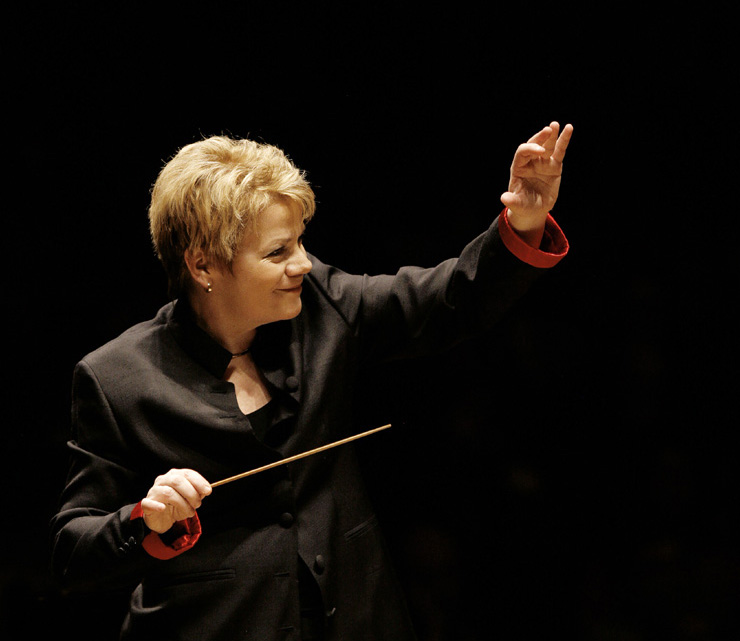
Santa Cruz’ Cabrillo Festival, the Eminence Gris of Contemporary Music, opened Friday, August 7 under the baton of Marin Alsop. Musicians arrived from all over the country to serve under her for the two-week festival that she has led since 1992.
Friday’s concert held two fine offerings and a finale that blew the cobwebs off the Santa Cruz Civic Auditorium. An already predisposed crowd, many of them repeat offenders, were completely unprepared for the moving power of Osvaldo Golijov’s Azul, or to the stunning virtuosity of cellist Alisa Weilerstein, much less to the seamless orchestration. And the wild cello-hyper accordion-dumbek trio added a coloration that is certain to be envied, and perhaps copied, by other composers.
Golijov refutes the thought that new music has to be difficult for the listener, with his fine craftsmanship and seamless transitions. His subject matter, the cerulean blues of a summer sky, is given depth by an expansive vision that infuses each moment.
Originally written for Yo Yo Ma to perform at Tanglewood in 2006, Golijov was dissatisfied with its over-emphasis on serenity, and rewrote it extensively for cellist Alisa Weilerstein. San Francisco Performances brought the young Weilerstein here for a recital last year (Dec 17, 2008 Piedmont Post), and her intensity and exuberance were even more apparent at this concert.
In remarks beforehand and at a composer’s forum the following morning Golijov was present to lend insight into his work. “It is a piece which never touches the ground. You know, how in Romantic music there are always [the rhythms of] horses…or motorcycles. The cello is like a bird, and soars in orbit, in constant motion. The form is Baroque, over which the cello reinvents the melody.”
Rumbling basses set the stage, a dark-hued loam over which the cello soloist entered. Inhabiting the top strings, she disdained the gravitas of the usual cello repertoire for a register that is eloquent and compelling. This first movement, Paz Sulfurica, develops its meditative motifs from the French Baroque composer, François Couperin. The orchestra began to inhabit her space—violins fluttered, horns laid down a broken ground of discords—and her melody was answered by hyper-accordion, an augmented electrified accordion played by its inventor, Michael Ward-Bergeman. Golijov’s coloring is reminiscent of fellow Argentinean Astor Piazzolla, who used bandoleon to transform the tango, but here it also stands as a Baroque continuo accompaniment.
Flutes and soft horns stepped past each other, a shimmer of near tuning to Weilerstein’s slow slides.
Then in Transit, amplified cello and accordion were joined by percussionists Jamey Haddad and Keita Ogawa to form an ensemble within the orchestra. They moved upbeat for a wild ride, smoking with dumbek and cowbell as Weilerstein sawed across all her strings in arpeggios that invoked Baroque but tasted of ragas and tango.
In the last movement, Yrushalem, the orchestra reasserted itself, with massive bass and brass livened by marimba. After two codas they tumbled back to earth to settle with a whisper.
The audience cheered until Weilerstein and her three cohorts returned for an encore, performing “Feira de Mangaio.” Virtuosity and heat were the order of the day, but one could also have wished to go home with Golijov’s spell unbroken.
This program opened with two excellent offerings, Brett Dean’s Amphitheatre and David Heath’s Rise From the Dark. Dean’s big blocks of sound and deliberate pacing left room for velvety textures—distant timpani, bass clarinet and bassoon against muted trombones. His open intervals painted the open air of an amphitheatre.
And Heath’s Rise, an almost-biography for a young life cut short, was disturbingly celebratory. Using jazz-influenced modulation and development, he moved around the orchestra, then settled in a slow melodic movement before returning to drama and brass fanfares.
—Adam Broner
Photo: Marin Alsop, conductor
